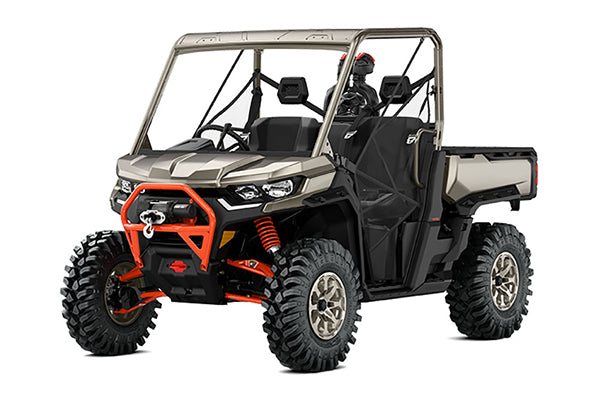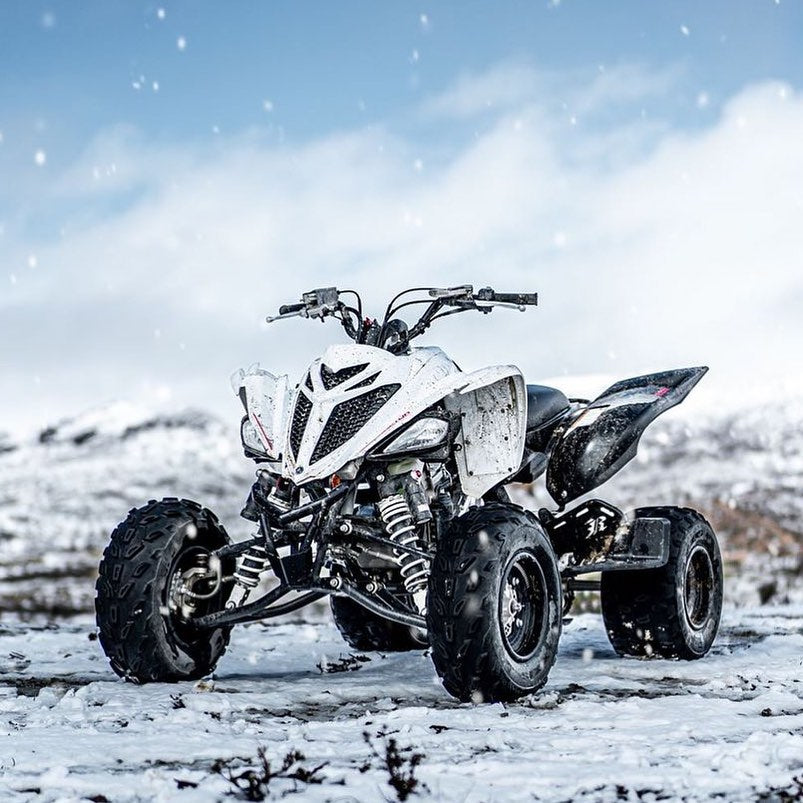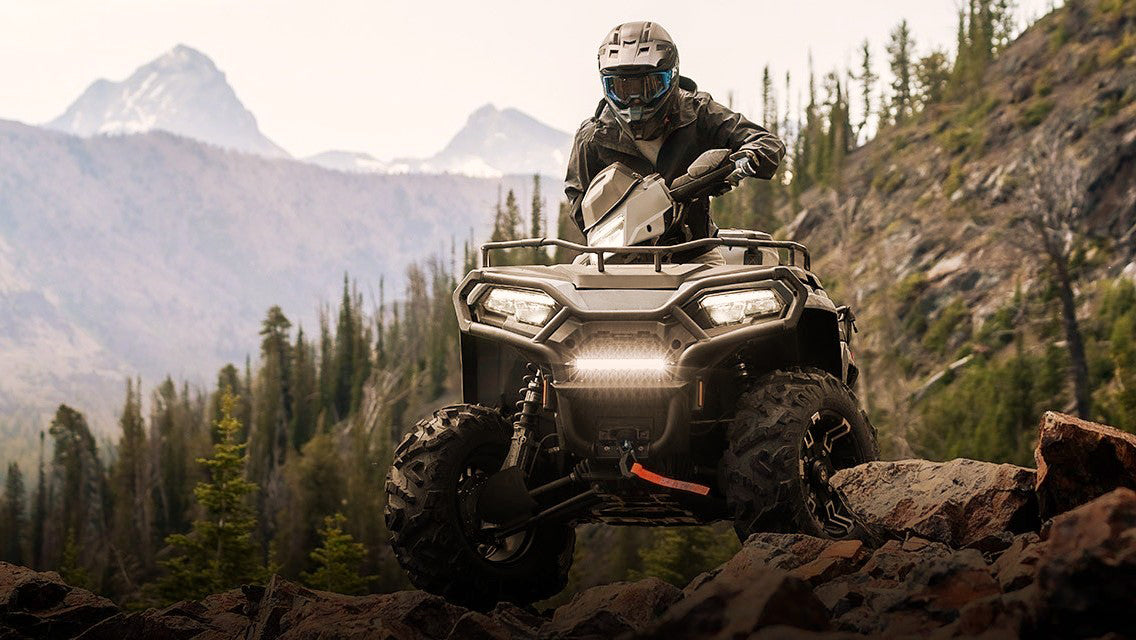As winter becoming colder and blankets the world in a snowy wonderland, ATV enthusiasts may question, whether it's possible to embark on thrilling rides with their Yamaha Raptor 700? Don't worry about that, the cold season presents an opportunity for unparalleled adventure. Join us as we delve into the tips and techniques that will allow you to conquer the winter trails and fully unleash the potential of your Raptor 700.

(Pic from @offroadridr)
Can You Ride Your ATV in Winter?
As the snowflakes fall, so do the myths surrounding winter ATV riding. It's time to debunk these misconceptions and address common concerns. Can you ride your ATV in freezing cold weather? The answer is definitely yes, the ATVs are built to be tough. But you should also do the proper preparation. We'll outline the safety and maintenance measures you can take to ensure a secure and enjoyable winter riding experience. Prepare to shatter the icy barriers and embrace the exhilaration that awaits.
Can Raptor 700 Master Snowy Conditions?
By design and construction, Yamaha Raptor 700 is a powerful and versatile ATV that thrives in challenging snowy terrains.(Raptor 700 Parts Here)
Equipped with a robust engine, the Raptor 700 delivers impressive acceleration and torque, allowing you to effortlessly navigate through the snow. Its advanced suspension system ensures a smooth and controlled ride, absorbing bumps and obstacles along the way.
The rugged and durable construction of the Raptor 700 ensures it can withstand the demands of winter riding. From its reinforced chassis to its sturdy frame, this ATV is built to endure harsh weather conditions and challenging terrains.
Its advanced fuel injection system ensures optimal fuel efficiency and consistent power delivery, even in cold weather conditions.
In conclusion,Yamaha Raptor 700 is a force to be reckoned with in snowy conditions.

(Pic from @offroadridr)
Useful Tips for Set up Raptor 700 for Winter Riding
Before embarking on your winter riding adventure, it's crucial to properly winterize your Raptor 700.
1.Finding the Perfect Grip on Snowy Trails
When it comes to conquering snow-covered trails, having the perfect grip is essential for any rider. Selecting the right atv snow tires for your Raptor 700 in snowy conditions significantly impacts your ATV's performance and safety. Specialized atv snow tires are designed with unique tread patterns and rubber compounds that enhance grip and traction on icy and snowy surfaces.
Consider investing in atv snow chains for your tires if you often ride in extremely icy or slippery terrains. These chains provide extra grip and stability, allowing you to confidently tackle even the most challenging snow-covered trails.
Furthermore,adjusting tire pressure can further enhance your Raptor 700's traction on snowy terrain. Lowering tire pressure increases the surface area of the tire in contact with the ground, allowing it to grip the snow more effectively. This adjustment helps prevent slippage and provides better control while riding in challenging winter conditions.
2.Suspension Setup: Conquering Snow and Ice
Understanding and optimizing your suspension settings is crucial for navigating snowy and icy terrains. As you encounter different textures and levels of grip, being able to make quick adjustments to your suspension settings allows for maximum traction and control. By making precise adjustments, you can enhance your Raptor 700's stability and control ability. Whether it's tweaking the compression or rebound settings, finding the perfect balance ensures a smooth and controlled ride even on the trickiest surfaces.
3.Cold Weather Fluids and Lubrication: Ensuring Peak Performance
When the mercury drops, the well-being of your Raptor 700's vital fluids and lubricants becomes crucial.
The first one to consider is the engine oil. Cold temperatures can cause oil to thicken, compromising its ability to properly lubricate the engine. Switching to a cold-weather engine oil with a lower viscosity ensures optimal lubrication even in frigid conditions, reducing wear and tear on engine components and promoting efficient performance.
Additionally, don't overlook the importance of selecting the right antifreeze or coolant for your Raptor 700. Freezing temperatures can wreak havoc on the engine's cooling system, leading to potential damage. Utilizing a cold-weather-specific antifreeze or coolant with a lower freezing point will safeguard against freezing and prevent costly repairs. And don't forget to pay attention to other vital fluids such as brake fluid and transmission fluid.

(Pic from the internet)
4.Preparing for Emergencies: Tools and Equipment to Carry
In times of unexpected situations, being prepared is of utmost importance.Carrying a well-stocked first aid kit is a good idea. Ensure your first aid kit includes bandages, antiseptic ointment, adhesive tape, and other essentials to address injuries promptly.
In addition to a first aid kit, having a reliable tow strap is crucial for tackling unexpected breakdowns or getting out of challenging situations. A high-quality tow strap allows you to safely and effectively recover your ATV or assist others in need. Make sure to select a strap with a suitable weight capacity and durable construction to handle any towing needs.
Carrying a multi-tool or a compact tool kit is also highly recommended. These versatile tools can help you address minor mechanical issues or make temporary repairs in the field. Include items such as wrenches, pliers, screwdrivers, and other commonly used tools that are compatible with your Raptor 700.
Also remember to carry essential items such as a flashlight, extra batteries, emergency blankets, and a signaling device. These items can be invaluable during unexpected situations, providing illumination, warmth, and the ability to attract attention for help if needed.
Stay Safe and Warm During Winter Raptor 700 Riding
1.Safety First: Winter Riding Techniques and Strategies
When riding through challenging winter conditions, safety should be your utmost priority.
One crucial safety measure is to never ride alone in winter conditions. Riding with a buddy ensures that you have someone to rely on and provides an extra layer of safety.
Additionally, setting reasonable limits is essential for ensuring a safe winter riding experience. Assess your skills, knowledge, and familiarity with the area before venturing into the snow-covered trails.
Adapting your riding style to the changing conditions is also paramount. Riding in snow and ice requires a different approach compared to other terrains. Reduce your speed, maintain a safe distance from other riders, and avoid sudden acceleration or braking. Gradual movements and smooth control inputs allow for better traction and stability on the slippery surfaces. Remember that the conditions can change rapidly, so stay vigilant and adjust your riding technique accordingly.
Furthermore, you should ensure proper visibility in winter riding. Wear a helmet with a visor or goggles that provide clear vision while shielding your face from cold winds. Keep your helmet visor fog-free by using an anti-fog solution or keeping it cracked open slightly to allow airflow. Additionally, wearing high-visibility gear or reflective clothing enhances your visibility to others on the trails, reducing the risk of accidents.

(Pic from the internet)
2.Layer Up: Dressing Appropriately for Cold Weather Riding
When preparing for winter riding, don't underestimate the significance of suitable gear, including ATV winter gloves and riding gear.
Selecting the right ATV winter gloves is vital for keeping your hands warm and protected from the biting cold. Look for gloves made from insulated materials that provide effective insulation while allowing for proper airflow. Ensure that they have a non-slip grip, as this will help you maintain control of the handlebars even in wet or snowy conditions. Additionally, consider gloves with reinforced padding or knuckle protection for added safety and durability.
Also don't forget to wear suitable winter ATV riding gear. This includes jackets, pants, and boots designed to withstand low temperatures and provide insulation without sacrificing comfort or mobility. Remember to choose gear made from waterproof and windproof materials to shield you from the elements.

(Pic from the internet)
Cleaning and Maintenance After Winter Rides
After conquering the winter trails, it's time to give your Raptor 700 the care it deserves.
1.Removing Salt and Debris: Cleaning Techniques for Winter Riding
Winter trails can leave behind a trail of salt and debris that can expedite wear and corrosion on your ATV. One area that requires special attention is the undercarriage of your Raptor 700. This region is particularly susceptible to salt and debris accumulation. Using a high-pressure hose or a pressure washer, carefully spray water underneath the ATV to dislodge and wash away any salt or debris trapped in hard-to-reach areas. Ensure that the water pressure is not too high to avoid damaging any sensitive components.
When it comes to cleaning the ATV's body, fenders, and other exposed parts, opt for a mild detergent or ATV-specific cleaning product,which can remove salt residue and debris without causing any harm to the paint or surfaces. Use a soft sponge or cloth to apply the cleaning solution, and gently scrub the affected areas. Rinse thoroughly with clean water to remove any remaining residue.
Don't forget to pay attention to areas that are often overlooked, such as the wheels and brakes. Use a safe wheel and brake cleaner according to the manufacturer's instructions, and use a brush or cloth to remove any stubborn residue.
After cleaning, it's important to dry your Raptor 700 thoroughly to prevent any lingering moisture. Use a soft cloth or chamois to carefully dry all surfaces, paying extra attention to crevices and areas where water may accumulate.
By following these effective cleaning techniques, you can remove salt and debris from your Raptor 700, protecting it against wear and corrosion.
2.Storing Your Raptor 700: Winterizing for the Off-Season
If you're considering storing your Raptor 700 after the snow riding, it's crucial to follow the necessary steps for proper winterization,so that ensure your ATV remains in optimal condition until your next adventure.
Begin by addressing the fuel system to prevent any issues caused by stale fuel. Add a fuel stabilizer to the gas tank and run the engine for a few minutes to ensure that the treated fuel reaches all parts of the system. This will help prevent fuel degradation and the build-up of varnish and deposits.It's also recommended to top off the gas tank to minimize the air space and prevent moisture accumulation.
Next, pay close attention to the battery to maintain its longevity.Fully charge the battery and then disconnect it to avoid any drain during storage. It's recommended to periodically recharge the battery throughout the off-season to keep it in optimal condition.
Creating suitable storage conditions is important for preserving your Raptor 700. Store it in a dry and well-ventilated area to prevent moisture buildup, which can lead to rust and corrosion. If possible, cover your ATV with a breathable, waterproof cover to protect it from dust, dirt, and any potential scratches. Elevating the tires off the ground with stands or blocks can help prevent flat spots and maintain tire shape during extended periods of storage.
Have you put aside all your worries about snow riding and started planning your next outdoor adventure? Embrace the freeze and cherish the unique scenery of every adventure!




